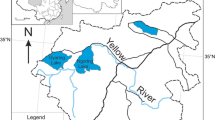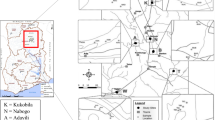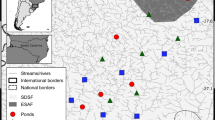Abstract
Wetlands are heterogeneous environments that harbor several species. In spite of playing a key role in aquatic ecosystems, macrophytes are the most neglected group in limnological studies. In the Brazilian subtropical highland grasslands, freshwater wetlands occur intermingled with native grasslands. Our objective was to assess species richness and variation in floristic composition along transects. We sampled 324 units to compare floristic similarity between and within areas based on non-metric multidimensional scaling (NMDS). We recorded plants of 40 families, 88 genera, and 133 species, out of which 17 are endangered. The richest families were Poaceae, Cyperaceae, and Asteraceae. The life forms found included amphibious, emergent, and fixed submerged types. The NMDS pointed to dissimilarity between and within areas. We observed the formation of two zones. In the outer zone, we detected seven indicator species and 17 exclusive species. In the inner zone, we detected five indicator species and 29 exclusive species. Our study suggests that wetlands are species-rich, heterogeneous environments characterized by different zones. The knowledge of biodiversity and presence of indicator species is key to the elaboration of strategies for the restoration and conservation of freshwater wetlands.




Similar content being viewed by others
References
Almeida JA, Albuquerque JA, Bortoluzzi RLC, Mantovani A (2007) Caracterização dos solos e da vegetação de áreas palustres (brejos e banhados) do Planalto Catarinense. Fundação Instituto de Ensino, Pesquisa e Extensão do Centro de Ciências Agroveterinárias, Lages
Alves JAA, Tavares AS, Trevisan R (2011) Composição e distribuição de macrófitas aquáticas na lagoa da Restinga do Massiambu, Área de Proteção Ambiental Entorno Costeiro, SC. Rodriguésia 62:785–801
Andrade AR, Baldo MC, Nery JT (2008) Variabilidade sazonal da precipitação pluviométrica de Santa Catarina. Acta Sci Technol 21:923–928
Balian EV, Segers H, Lévèque C, Martens K (2008) The freshwater animal diversity assessment: an overview of the results. Hydrobiologia 595:627–637
Baptista LRM, Lorscheitter ML, Scherer C (2012) Floristic composition of a Subtropical bog, Eastern Plateau from southern Brazil. Check List 8:224–236
Boldrini II, Eggers L, Mentz LA, Miotto STS, Matzenbacher NI, Longhi-Wagner HM, Trevisan R, Schneider AA, Setúbal RB (2009) Flora. In: Boldrini II (Org). Biodiversidade dos Campos do Planalto das Araucárias. Série Biodiversidade (v. 30). Ministério do Meio Ambiente, Brasília
Borcard D, Gillett F, Legendre P (2011) Numerical ecology with R series: use R. Spring Science, New York
Bove CP, Gil ASB, Moreira CB, Anjos RFB (2003) Hidrófitas fanerogâmicas de ecossistemas aquáticos temporários da planície costeira do Estado do Rio de Janeiro, Brasil. Acta Bot Bras 17:119–135
Brasil (2010) Resolução no 423, de 12 de abril de 2010. http://www.mma.gov.br/port/conama/legiabre.cfm?codlegi=628. Accessed 2015 Apr 10
Dufrene M, Legendre P (1997) Species assemblages and indicator species: the need for a flexible asymmetrical approach. Ecol Monogr 67:345–366
Esteves FA (1998) Fundamentos de limnologia, 2nd edn. Interciência, Rio de Janeiro
Eugenio CUO, Munhoz CBR, Felfili JM (2011) Dinâmica temporal do estrato herbáceo-arbustivo de uma área de campo limpo úmido em Alto Paraíso de Goiás, Brasil. Acta Bot Bras 25:497–507
Ferreira FA, Mormul RP, Pedralli G, Pott VJ, Pott A (2010) Estrutura da comunidade de macrófitas aquáticas em três lagoas do Parque Estadual do Rio Doce, Minas Gerais, Brasil. Hoehnea 37:43–52
Higuchi P, Silva AC, Aguiar MD, Mafra AL, Negrini M, Zech DF (2014) Partição espacial de espécies arbóreas em função da drenagem do solo em um fragmento de floresta com araucária no sul do Brasil. Ciência Florest 24:421–429
Iganci JEV, Heiden G, Miotto STS, Pennington RT (2011) Campos de Cima da Serra: the Brazilian subtropical high land grasslands show an unexpected level of plant endemism. Bot J Linn Soc 167:378–393
Instituto Nacional de Meteorologia—INMET (2014) Dados climáticos da Estação de São Joaquim: série histórica de 1961 a 2012. Banco de dados do Instituto Nacional de Meteorologia. http://www.inmet.gov.br/. Accessed 2014 Jun 5
Irgang BE, Gastal Júnior SVS (2003) Problemas taxonômicos e distribuição geográfica de macrófitas aquáticas do sul do Brasil. In: Thomaz SM, Bini LM (eds) Ecologia e Manejo de Macrófitas Aquáticas. Universidade Estadual de Maringá, Maringá, pp 163–170
Irgang BE, Pedralli G, Waechter JI (1984) Macrófitas aquáticas da Estação Ecológica do Taim¸ Rio Grande do Sul. Brasil. Roessleria 6:395–404
Iucn Red List of Threatened Species—IUCN (2015). www.iucnredlist.org. Accessed 2015 May 5
Jiao C, Zhou D (2013) Modeling the spatial distribution of Carex pseudocuraica in a freshwater marsh, northeast China. Wetlands 34:267–276
Junk W (1993) Wetlands of tropical South America. In: Whigham DF, Dykyjová D, Andhejný S (eds) Wetlands of the world I: inventory, ecology and management. Kluwer Academic Publishers, London, pp 679–739
Junk W (2002) Long-term environmental trends and the future of tropical wetlands. Environ Conserv 29:414–435
Krebs CJ (1999) Ecological methodology, 2sd edn. University of British Columbia, California
Lista de Espécies da Flora do Brasil (2014) http://floradobrasil.jbrj.gov.br/jabot/listaBrasil/ConsultaPublicaUC/ConsultaPublicaUC. Accessed 2015 May 1
Magalhaes TL, Bortoluzzi RLC, Mantovani A (2013) Levantamento florístico em três áreas úmidas (banhados) no Planalto de Santa Catarina, Sul do Brasil. Revista Brasileira de Biociências 11:269–279
Ministério do Meio Ambiente (MMA) (2014 Instrução normativa no 443, de 17 de dezembro de 2014: Lista oficial das espécies da flora brasileira ameaçadas de extinção. http://cncflora.jbrj.gov.br/portal/pt-br/listavermelha. Accessed 2015 May 5
Moreira SN, Pott A, Pott VJ, Damasceno-Junior GA (2011) Structure of pond vegetation of a vereda in the Brazilian Cerrado. Rodriguésia 62:721–729
Murray-Hudson M, Lane CR, North S, Rown MT (2012) Macrophyte species distribution, indices of biotic integrity and sampling intensity in isolated Florida Marshes. Wetlands 32:449–460
Pinheiro MNM, Hortêncio MM, Evangelista RAO (2012) Distribuição espacial da biodiversidade de macrófitas aquáticas nos lagos da região nordeste do estado de Roraima. Revista Geonorte 1:162–174
Pott VJ, Pott A (2000) Plantas aquáticas do pantanal. Embrapa, Brasília
Prado PIKL (2009) Distribuição de abundância de espécies. Ciência e Ambiente 39:121–136
R Development Core Team (2013) R: a language and environment for statistical computing. http://www.R-project.org. Accessed 2014 Jun 14
Rocha DC, Martins D (2011) Adaptações morfoanatômicas de cyperaceae ao ambiente aquático. Planta Daninha 29:7–15
Rolon AS, Homem HF, Maltchik L (2010) Aquatic macrophytes in natural and managed wetlands of Rio Grande do Sul State, Southern Brazil. Acta Limnol Bras 22:133–146
Santa Catarina (ESTADO). 2009. Lei nº 14675, de 13 de abril de 2009
Santamaria L, Van Vierssen W (1997) Photosynthetic temperature responses of fresh- and brackish-water macrophytes: a review. Aquat Bot 58:135–150
Schaefer-Santos J, Lingnau C, Galvão F (2013) Mapeamento de campos hidromórficos na Serra Catarinense por meio de modelagem hidrológica. Floresta e Ambiente 20:316–326
Author information
Authors and Affiliations
Corresponding author
Rights and permissions
About this article
Cite this article
de Magalhaes, T.L., da Costa Bortoluzzi, R.L. & Mantovani, A. Plant distribution in freshwater wetlands of the Brazilian subtropical highland grasslands. Braz. J. Bot 39, 239–249 (2016). https://doi.org/10.1007/s40415-015-0226-y
Received:
Accepted:
Published:
Issue Date:
DOI: https://doi.org/10.1007/s40415-015-0226-y




